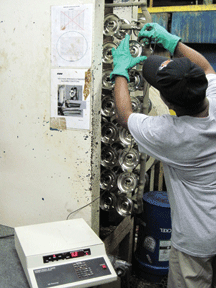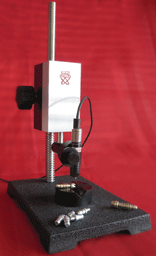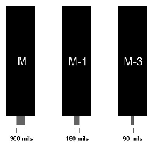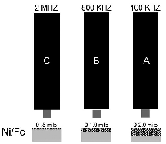



PSEC measures coating thickness based on the conductivity difference between the coating and the base material. (A conductivity difference of 20% or more is required in order to measure using this technique.) Eddy current is designated by ASTM B659-90, which states “that the magnitude of eddy currents is a function of the relative electrical conductivities of the coating and substrate materials and the coating thickness.”
Specially designed eddy current probes can be chosen according to the application thickness range of the coating, and the size of the parts being measured. Measurements are made by holding the probe perpendicular to the part with the probe tip in contact to the surface.
There are actually two types of eddy current techniques that are used for measuring coating thickness. The most common type is “amplitude” eddy current, which is capable only of measuring non-conductive coatings over conductive (non-ferrous) substrates. The most common applications for amplitude eddy current are for measuring anodizing and organic finishes on aluminum substrates.
While the phase-sensitive eddy current technique also measures anodizing, the real advantage comes in the possibility of measuring many different applications, even with the same probe. Since PSEC measurements are based on having at least a 20% difference in conductivity between the coating and substrate, the variation of applications is almost unlimited.
We could not list all of the various applications that PSEC is capable of measuring, but some of the many possibilities include: Ni/Fe, Cu/Fe, Ag/SS, Cu/EPG, RFI & EMI coatings on plastic, Silicide/SS, Sn/Fe and Cu/Fe, Anodizing/Al, Al/Glass, Al/SS or Cr/Al. The most common use of PSEC is for measuring zinc, copper or cadmium thickness on steel fasteners.
Instrument Calibration and Thickness StandardsTypical applications for measuring plating thickness such as zinc/steel require calibration of the instrument using plated thickness standards. The specific thickness of the calibration standards depends on the frequency of the probe.
ASTM specifies using calibration standards identical to the parts being measured. In the case of PSEC, this means making calibration standards having the same characteristics in both the coating and substrate as the parts being plated.
Most eddy current instruments incorporate a base correction feature that adjusts for different properties of substrates. Differences in plating deposit conductivity can also be corrected by incorporating an algebraic factor. Though these system adjustments are helpful, using a “factor” to change the original calibration causes a loss of NIST traceability. Thus, to obtain maximum accuracy, thickness standards should be made from the same plating bath and substrate materials as the parts that will be measured. Otherwise, to confirm the accuracy a different measurement method should be used for comparison purposes. Most eddy current instruments also include the magnetic induction capability for this purpose.
Eddy Current AdvantagesEddy current instruments are rugged, with the electronics virtually sealed, and can be used directly at the end of a plating line or other hostile work environments.
Another benefit: eddy current is much less affected by subtle changes of the magnetic properties of steel or iron substrates. Most low-carbon steel substrates can be measured using a single calibration and only one set of standards would be needed for measuring thousands of different parts such as screws, washers, bolts or brackets.
Curved and irregularly shaped parts can be measured with little additional error and typically without the necessity of parts fixturing. This is due to the small measurement areas (field effect) of microprobes. Plating thickness can also be measured on rough, uneven surfaces without affecting he overall accuracy. Thickness distribution can also be scanned by sliding the probe along critical surfaces of the parts.
With PSEC, there is a high degree of measurement precision (repeatability) even on thin metallic coatings. Since most plating specifications are typically less than 0.5 mils, this is an important feature. For example, vacuum deposits for EMI/RFI applications, such as aluminum or copper on plastic substrates are commonly below 0.1 mils, but can be accurately measured even below 1 micron by eddy current using the appropriate probe and thickness standards.
Platings such as zinc can be measured even under a coat of paint with no loss of accuracy. The “lift off” of the probe from the surface will not affect accuracy of the zinc measurement. Eddy Current ProbesA wide variety of specially designed probes are available from the manufacturers for use in measuring virtually any application or part. Probes with different tip diameters are sized to accommodate the size and shape of the parts being measured. Probes with smaller tips can measure on very small areas of parts less than 90 mils. Smaller probe tips are subject to increased wear and are more easily worn or damaged, so probes are also produced with larger diameter tips for measuring on larger parts such as plated brackets or castings.
Depth of measurement penetration is a function of the conductivity of the coating and substrate as well as the frequency of the probe being used. The specific frequency for the probe is chosen depending on the application plus the coating thickness specification. Lower frequency probes penetrate deeper into the parts than higher frequencies. The higher the probe frequency, the better the accuracy will be for measuring thinner coatings.
Right angle probes are also available that can be used to determine thickness inside bores as small as .250" diameter. Placing and holding the probe steady at the proper angle inside a bored hole is very difficult, increasing likelihood of measurement error due to improper probe positioning.
To obtain the maximum accuracy achievable, a probe stand should be used for measuring inside internal bores or on small part surfaces.
With PSEC the same probe can often be used for measuring different applications. For example, conductive coatings on steel and non-conductive coatings on conductive substrates can be measured using the same probe.
SummaryPhase-sensitive eddy current technology provides an excellent option to metal finishers for measurement of many application combinations. With phase-sensitive eddy current systems available for about $6,000, the eddy current method provides a relatively inexpensive alternative for accurately determining coating thickness.
Eddy current systems are easy to operate with menu-driven, prompting software, so even non-technical operators can make instantaneous, accurate and repeatable thickness measurements directly on the process line for improved throughput, quality control and fewer rejections. Many of the largest volume platers use eddy current systems at the end of the plating line for direct process control and incorporate X-Ray in the quality lab for final inspection. Using this combination of technologies ensures the most efficient method to achieve conformance to thickness specifications BioMike Justice, president of West Chester, Ohio–based UPA Technology, has 25 years experience in instrumentation and standards for the measurement of coatings. He earned his B.S. degree in Industrial Technology from Ohio State University. He can be reached at info@upa.com






